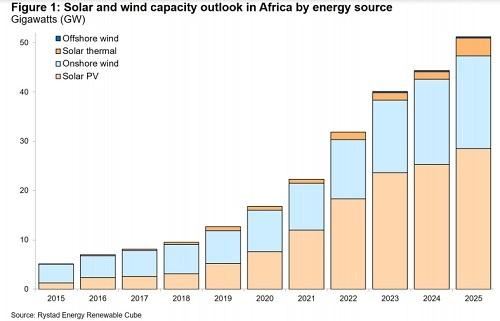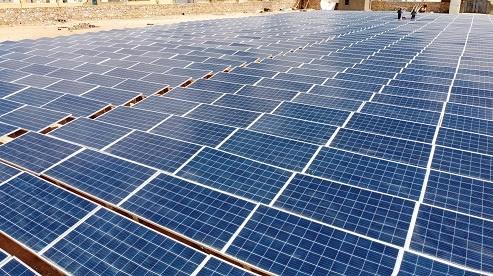Africa’s installed capacity of renewable energy, which stood at 12.6 gigawatt (GW) in 2019, is set for consecutive years of growth, a Rystad Energy analysis shows
The continent’s capacity is forecast to reach 16.8 GW in 2020, add another 5.5 GW in 2021, and further climb to 51.2 GW in 2025, led by growth in solar and wind projects in Egypt, Algeria, Tunisia, Morocco and Ethiopia.
At present, South Africa leads the continent in terms of installed renewable energy capacity with 3.5 GW of wind, 2.4 GW of utility solar, and a solar-dominant 1 GW pipeline of projects in development. Egypt and Morocco are in second and third place in terms of solar capacity with 1.6 GW and 0.8 GW, respectively.
Nearly 40 out of 50 African countries have installed – or plan to install – wind or solar projects. And although the learning curve may be steep for first-time market entrants with sizable development pipelines, inexperienced players will be able to leverage the lessons learned in Egypt, South Africa and Morocco and implement this knowledge into development plans.
Algeria will see the most renewable growth in Africa towards 2025, increasing capacity from just 500MW in 2020 to almost 2.9GW in 2025. The increase will come primarily from one mega-project, the four gigawatts Tafouk 1 Mega Solar Project, which will be developed in five phases of 800MW capacity each, to be tendered between 2020 and 2024. Rystad Energy expects three of the tendered projects with 2.4GW of capacity will be commissioned by 2025.
Tunisia will also see formidable growth, skyrocketing from 350 MW of renewable capacity in 2020 to 4.5 GW in 2025.

The additions will come from larger solar plants, such as the 2 GW TuNur Mega Project, which is currently in the early stages of development and is expected to come on line by 2025.
In terms of speed, Egypt has been one of the quickest African nations to install solar and wind since 2017, and currently has approximately three gigawatts of installed capacity. The country has a massive 9.2GW development pipeline, which mostly consists of wind projects – putting Egypt on track to overtake South Africa in 2025 and become the green powerhouse of Africa.
Growth will come from large projects such as the 2 GW Gulf of Suez Red Sea Wind Project, which will be located in the governorate of the Red Sea. Of the capacity to be installed, 500 MW will be developed by German giant Siemens Gamesa and 1,500 MW remains to be awarded. Four out of the top 10 projects to be developed in Africa in the next five years will be in Egypt, underscoring the Egyptian government’s commitment to its renewable goals.
Morocco follows Egypt in terms of the quick pace of installations with 2.5 GW of installed capacity, dominated by 1.7GW of wind power. Rystad Energy expects solar will drive the growth there, with a handful of large projects already in the works such as the one gigawatt Noor Midelt Hybrid (CSP + Solar PV), the 400 MW Noor PV II, and the 120 MW Noor Tafilalet.
Ethiopia’s capacity numbers will also take a huge leap: the county currently has only 11MW of installed solar capacity and close to 450MW of installed wind, but is expected to have three gigawatts of renewable capacity on line by 2025. The Tigray Hybrid Project will drive this increase and is expected to contribute at least 500 MW of solar capacity by 2025, assuming a resolution to the current ongoing conflict by then.
The cost of renewables is at an all-time low now, and as larger markets such as China, India and Europe are on track to reach installation targets, wind and solar components will become ever cheaper and more easily accessed, creating a conducive environment for investment also in Africa.
“Development on the continent has historically been slow due to political instability, lagging policy and infrastructure, and poor procurement. However, as electricity demand increases, many African nations are turning to renewable solutions to meet energy targets, with solar overtaking wind in the next five years as the renewable technology of choice,“ said Gaurav Metkar, analyst at Rystad Energy.





















